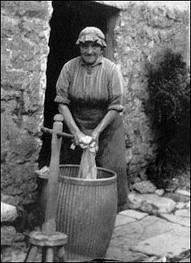By Daniel Dressman, Oakland on September 22, 2014
On August 20, 2014, the California Supreme Court granted review in two “take-home” asbestos exposure cases, Kesner v. Superior Court (2014) 226 Cal.App.4th 251, a negligence and products liability case, and Haver v. BNSF Railway Co. (2014) 226 Cal.App.4th 1104, a premises liability case. “Take-home” cases, aka “secondary exposure” cases, involve plaintiffs alleging exposure to a harmful substance, not from working with a product or at a site that contained the substance, but through their contact with a person (oftentimes a family member) who brought the substance home on their clothing, tools or vehicles.
The key issue in most take-home cases, which is discussed at length in the Kesner and Haver opinions, is whether the defendant employer or premises owner has a legal duty to these plaintiffs. In granting review, the California Supreme Court has an opportunity to curb the number of “take-home” cases asserted in this state.
In Kesner, the plaintiff was sometimes a guest at the home of his uncle, who was employed by defendant Abex manufacturing asbestos-containing products. Kesner held that this was sufficient to create a duty, and that an employer’s duty of care “runs at least to members of an employee’s household who are likely to be affected by toxic materials brought home on the worker’s clothing.” Kesner focused on the foreseeability of harm.
Kesner distinguished the seminal California “take-home” case of Campbell v. Ford Motor Co. (2012) 206 Cal.App.4th 15,which held that “a property owner has no duty to protect family members of workers on its premises from secondary exposure to asbestos used during the course of the property owner’s business.” Kesner held a “different balance must be struck” when analyzing a negligence claim than with (as in Campbell) a premises liability claim. Kesner “did not question the conclusion in Campbell.” In essence, Kesner carved out an exception to Campbell, allowing the plaintiffs to skirt the bright-line rule by bringing take-home claims under a products liability theory, of course for cases like this or similar the use of family lawyers Melbourne can be the best option to help you in this area.
A month after the Kesner decision, the Haver court found no “take-home” duty and affirmed a demurrer in favor of defendant BNSF Railway. The plaintiff was the son of the decedent, alleging his mother inhaled asbestos fibers from her contact with her former husband, who used to work for defendant’s predecessor. On appeal, the plaintiff argued that Campbell was improperly decided or, in the alternative, that the Kesner case compelled a different outcome. The Haver court rejected both of plaintiff’s arguments, holding instead that “Campbell made clear that its no duty rule encompassed all plaintiffs who suffered secondary exposure to asbestos off the landowner’s property, regardless of the frequency … or the worker’s employment relationship with the landowner.”
As a result of the California Supreme Court’s decision to grant review, the Kesner and Haver decisions have been depublished and may not be cited in California, leaving Campbell as the law in California while the appeals are pending. The decisions may still be cited in most jurisdictions outside California,
It should be noted that the holding in Campbell is not followed in all jurisdictions. For example, courts in New Jersey (Olivo v. Owens-Ill., Inc. 186 N.J. 394, 404 (N.J. 2006) (premises liability)), Louisiana (Chaisson v. Avondale Industries, Inc., 947 So.2d 171(La. App. 2007) (premises liability)), and Tennessee (Satterfield v. Breeding Insulation Co. 266 S.W.3d 347, 366-367 (Tenn. 2008) (negligence)) have found that an employer or landowner has a legal duty.
But there is reason to believe that the California Supreme Court will follow Campbell’slead, which aligns with the majority of other states. States recognizing no duty in take-home exposure cases include: Delaware (Price v. E.I. DuPont De Nemours & Co., 26 A.3d 162, 170 (Del. 2011)); Georgia (CSX Transp., Inc. v. Williams, 608 S.E. 2d 208 (Ga. 2005)); Iowa (Van Fossen v. MidAmerican Energy Co., 777 N.W.2d 689, 699 (Iowa 2009)); Kansas (Kan. Stat. Ann. § 60-4905(a) (2012)); Maryland (Adams v. Owens-Illinois, Inc., 705 A.2d 58 (Md. Ct. App. 1998)); Michigan (Miller v. Ford Motor Co. (In re Certified Question from Fourteenth District Court of Appeals of Texas), 740 N.W.2d 206, 222 (Mich. 2007)); New York (In re New York City Asbestos Litigation (Holdampf. v. A.C. & S. Inc.), 5 N.Y.3d 486 (2005)); Ohio (Boley v. Goodyear Tire & Rubber Co., 929 N.E.2d 448, 453 (Ohio 2010); R.C.2307.941); and Texas (Alcoa, Inc. v. Behringer, 235 S.W.3d 456 (Tex. App. 2007)). As noted in Haver, the New York and Georgia high courts ruled that finding a legal duty would “upset traditional tort law” and “result in unsound public policy.”
In Kesner, Gordon & Rees partner Don Willenburg submitted an amicus brief on behalf of two defense counsel organizations. The amicus brief argues that Campbell should control all take-home cases, and that a contrary rule (like that the Kesner court adopted) would open the door to a potentially limitless pool of plaintiffs claiming lung cancer and other diseases.
The Kesner and Haver decisions will likely generate significant amicus interest. Amicus briefs are generally filed shortly after the final reply brief of the parties, or about three-four months from now. There is no set timetable for the California Supreme Court to hear argument on or decide the matter after briefing, but we estimate a decision may issue in about 18-24 months. Gordon & Rees has extensive experience in appeals on a wide variety of legal issues and has submitted numerous amicus briefs in cases that resolved favorably for the defense.
The California Supreme Court should adopt the rule in Campbell and the majority of other jurisdictions. And, in the opinion of the author, the holding should extend to premises liability, product liability, and negligence claims to reflect a unifying legal principle that an employer or landowner – even if the employer or landowner also happens to be a manufacturer – has no legal duty to protect someone from secondary exposure who never used the product or never visited the site.

 Dr. Ernest V. Quiroz was allegedly exposed during his childhood to asbestos brought home on his father’s work clothes from the Reynolds Metals extrusion plant in Phoenix. Dr. Quiroz left the family home at age 14 to attend seminary high
Dr. Ernest V. Quiroz was allegedly exposed during his childhood to asbestos brought home on his father’s work clothes from the Reynolds Metals extrusion plant in Phoenix. Dr. Quiroz left the family home at age 14 to attend seminary high Plaintiff Doris Jane Neumann alleges that she contracted malignant mesothelioma through exposure to asbestos-containing products as a result of laundering the clothes of her son, who used asbestos-containing friction paper during his work as a mechanic. Originally filed in state court, the case was removed to federal court on diversity grounds. Subsequently, defendant MW Custom Papers moved for dismissal under Federal Rule of Civil Procedure 12(b)(6), alleging that it could not be found liable for negligence because it did not owe Doris Jane Neumann a duty of care under Illinois law.
Plaintiff Doris Jane Neumann alleges that she contracted malignant mesothelioma through exposure to asbestos-containing products as a result of laundering the clothes of her son, who used asbestos-containing friction paper during his work as a mechanic. Originally filed in state court, the case was removed to federal court on diversity grounds. Subsequently, defendant MW Custom Papers moved for dismissal under Federal Rule of Civil Procedure 12(b)(6), alleging that it could not be found liable for negligence because it did not owe Doris Jane Neumann a duty of care under Illinois law. The typical “take-home” plaintiff is a bystander such as the child who claims she was exposed to asbestos while playing in the basement where her father’s work clothes covered with asbestos dust were laundered. Across the United States, the battle lines are being drawn in these “take-home” or “household” asbestos cases. In a
The typical “take-home” plaintiff is a bystander such as the child who claims she was exposed to asbestos while playing in the basement where her father’s work clothes covered with asbestos dust were laundered. Across the United States, the battle lines are being drawn in these “take-home” or “household” asbestos cases. In a  "limitless liability", New York trial courts continue to distinguish cases on their facts to permit recovery for "take-home" claimants.
"limitless liability", New York trial courts continue to distinguish cases on their facts to permit recovery for "take-home" claimants.  Judge Heitler ruled that the Court of Appeals holding in Holdampf could not be relied upon by the LIRR because the facts presented in Frieder were different, to wit, LIRR had control of the workplace where the dinner was located (inside the walls of the rail yard). Under this unique set of facts, she reasoned, her ruling would neither run afoul of Holdampf nor open the floodgates of "limitless liability". Based upon her discussion of the "take-home" case law, Judge Heitler appears prepared to apply the brakes to "take-home" asbestos claims in New York City.
Judge Heitler ruled that the Court of Appeals holding in Holdampf could not be relied upon by the LIRR because the facts presented in Frieder were different, to wit, LIRR had control of the workplace where the dinner was located (inside the walls of the rail yard). Under this unique set of facts, she reasoned, her ruling would neither run afoul of Holdampf nor open the floodgates of "limitless liability". Based upon her discussion of the "take-home" case law, Judge Heitler appears prepared to apply the brakes to "take-home" asbestos claims in New York City.  tort exposure claims. In an insightful article appearing in
tort exposure claims. In an insightful article appearing in